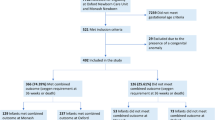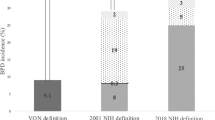Abstract
Objective:
To compare the incidence of oxygen dependency in SIBEN neonatal units while adjusting for altitude.
Study Design:
We reviewed the charts of infants who were⩽1500 g at birth, admitted to six neonatal intensive care units (NICUs) near sea level and in seven NICUs at varying altitudes above sea level from the SIBEN network between 2008 and 2010. We defined bronchopulmonary dysplasia (BPD) as oxygen dependency at 28 days of life and at 36 weeks postmenstrual age.
Result:
There were 767 babies in the first group and 318 in the second group. BPD incidence was greater in hospitals at higher altitudes when it was not corrected for barometric pressure. After correction, there was a decrease in the incidence of oxygen dependency at 28 days of life (P<0.0002) and at 36 weeks corrected age. (P<0.0001)
Conclusion:
After correction for higher altitudes, the decrease in oxygen dependency as equivalent to BPD was significant. A proper classification of BPD for higher altitudes is urgently needed.
This is a preview of subscription content, access via your institution
Access options
Subscribe to this journal
Receive 12 print issues and online access
$259.00 per year
only $21.58 per issue
Buy this article
- Purchase on Springer Link
- Instant access to full article PDF
Prices may be subject to local taxes which are calculated during checkout

Similar content being viewed by others
References
Goldsmith JP . Ventilación asistida neonatal. ED Distribuna, Bogotá, Colombia 2005.
Jobe AH, Bancalari E . Bronchopulmonary displasia. Am J Respir Crit Care Med 2001; 163: 1723–1729.
Northway WH Jr . Observations on bronchopulmonary dysplasia. J Pediatr 1979; 95: 815–818.
Walsh MC, Yao Q, Gettner P, Hale E, Collins M, Hensman A et al. Impact of a Physiologic definition on broncopulmonary dysplasia rates. Pediatrics 2004; 114: 1305–1311.
Castillo A, Sola A, Baquero H, Neira F, Alvis R, Deulofeut R et al. Pulse oxygen saturation levels and arterial oxygen tensión values in newborns receiving oxygen therapy in the neonatal iintensive care unit: Is 85% to 93% and aceptable range?. Pediatrics 2008; 121: 882–889.
Tapia-Rombo CA, Munayer-Calderón J, Salazar Acuña AH, Álvarez-Vázquez E, De-Los-Santos-Soriano H, Regalado-Rebollo HG et al. Hemodynamic indexes in newborn using arteriovenous oxygen content difference. Rev Invest Clin 1998; 50: 191–196.
Subhi R, Smith K, Duke T . When should oxygen be given to children at hight altitude? A systematic review to define altitude-specific hipoxaemia. Arch Dis Child 2009; 94: 6–10.
Gonzales GF, Salirrosa A . Arterial oxygen saturation in healthy newborns delivered at term in Cerro de Pasco (4340m) and Lima(150m). Reprod Biol Endocrinol 2005; 3: 46.
Postigo L, Heredia G, Illsley NP, Torricos T, Dolan C, Echalar L et al. Where the O2 goes to: prevention of human fetal oxygen delivery and consumption at high altitude. J Physiol 2009; 583: 693–708.
Ravert P, Detwiler TL, Dickinson JK . Mean oxygen saturation in well neonates at altitudes between 4498 and 8150 feet. Adv Neonatal Care 2011; 11: 412–417.
Peacock A . Oxygen at high altitude. BMJ 1998; 317: 1063–1066.
Finer NN, Bates R, Tomat P . Low flow oxygen delivery via nasal cannula to neonates. Pediatr Pulmonol 1996; 21: 48–51.
Walsh M, Engle W, Laptook A, Nadya S, Kazzi J, Butcher S, Rasmussen M et al. Oxygen delivery through nasal cannule to preterm infants:can practice be improved?. Pediatrics 2005; 116: 857–861.
SUPPORT study of the Eunice Kennedy Shriver NICHD Neonatal Research Network. Target ranges of oxygen saturation in extremely preterm infants. N Engl J Med 2010; 362: 1959–1969.
Duke T, Blaschke AJ, Sialis S, Bohkowsky J . Hypoxaemia in acute respiratory and non respiratory illneses in neonates and children ina developing country. Arch Dis Child 2002; 86: 108–112.
Dyke T, Lewis D, Heegaard W, Manary M, Flew S, Rudeen K . Predicting hypoxia in children with acute lower respiratory infection: a study in the highlands of Papua Bew Guinea. J Trop Pediatr 1995; 41: 196–201.
Saugstad OD, Aune D . In search of the optimal oxygen saturation for extremely low birth weight infants: a systematic review and meta-analysis. Neonatology 2011; 100: 1–8.
Saugstad OS, Speer CP, Halliday HL . Oxygen saturation in immature babies: revisited with updated recommendations. Neonatology 2011; 100: 217–218.
World Health Organization World Health Organization Pocket book of hospital care for children: guidelines for the management of common illnesses with limited resources. 2005, Geneva: WHO.
Sweet DG, Carnielli V, Greisen G, Hallman M, Ozek E, Plavka R et al. European consensus guidelines on the management of neonatal respiratory distress syndrome in preterm infants-2013 update. Neonatology 2013; 103: 353–368.
Britton JR . Altitude, oxygen and the definition of bronchopulmonary dysplasia. J Perinatol 2012; 32: 880–885.
Acknowledgements
We thank Leticia Echániz MD for her assistance in the translation of this paper, and Jacov Rabi and Alixe Howlett for reviewing the manuscript. We also thank the reviewers for their insightful comments that enhanced the study.
THE SITE INVESTIGATORS OF THE SIBEN NEONATAL NETWORK
Carlos Alfonso Fajardo (Director of the SIBEN Neonatal Network): Liliana Espelet Hospital E. Ferreyra Necochea Argentina; Guillermo A. Zambosco: Hospital Italiano de La Plata, La Plata, Argentina; Maria V. Favareto: Hospital Provincial de Rosario, Rosario, Argentina; Graciela Otero: Hospital Dr A. Duhau, Buenos Aires, Argentina; José María Rodriguez P.: PIT UTI NEONATAL E PEDIATRICA, Sao Paulo, Brasil; Angela Hoyos: Clínica del Country, Bogotá, Colombia; Rafael Tovar: Hospital Universidad, del Norte, Barranquilla, Colombia; Oscar Ovalle: Clínica Materno Infantil Cruz Blanca, Bogotá, Colombia; Ana Lucia Torres, SERVIUCIS, Rionegro, Colombia; Catherine Rojas: Hospital Centro Policlínico Olaya, Bogotá, Colombia; Francisco Xavier Jijón: Hospital Metropolitano, Quito, Ecuador; Luis A. Fernandez C.: Instituto Nacional de Perinatología, México, D. F., México; Tania Paredes: Instituto Nacional Materno Perinatal, Lima, Perú.
Author information
Authors and Affiliations
Consortia
Corresponding author
Ethics declarations
Competing interests
The authors declare no conflict of interests.
Rights and permissions
About this article
Cite this article
Fernández, C., Fajardo, C., Favareto, M. et al. Oxygen dependency as equivalent to bronchopulmonary dysplasia at different altitudes in newborns ⩽1500 g at birth from the SIBEN network. J Perinatol 34, 538–542 (2014). https://doi.org/10.1038/jp.2014.46
Received:
Revised:
Accepted:
Published:
Issue Date:
DOI: https://doi.org/10.1038/jp.2014.46
This article is cited by
-
Bronchopulmonary dysplasia: effect of altitude correction and role for the Neonatal Research Network Prediction Algorithm
Journal of Perinatology (2018)



